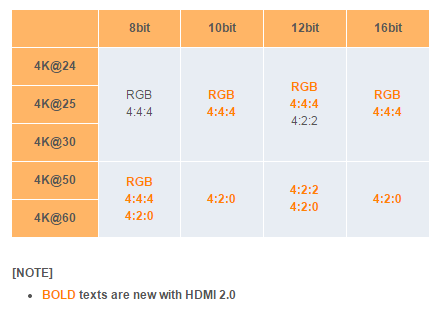 Current Position: Home >Warranty Policy
Current Position: Home >Warranty Policy-
Q: How do I run HDMI cables longer than 10 meters?
There are many HDMI Adopters working on HDMI solutions that extend a cable’s effective distance from the typical 10 meter range to much longer lengths. These companies manufacture a variety of solutions that include active cables (active electronics built into cables that boost and extend the cable’s signal), repeaters, amplifiers as well as CAT5/6 and fiber solutions.
-
Q: Is HDMI backward compatible with DVI (Digital Visual Interface)?
Yes, HDMI is fully backward compatible with DVI compliant devices. HDMI DTVs will display video received from existing DVI-equipped products, and DVI-equipped TVs will display video from HDMI sources. However, some older PCs with DVI are designed only to support computer monitors, not televisions. Consumers buying a PC with DVI should make sure that it specifically includes support for television formats and not just computer monitors.
Also, consumers may want to confirm that the DVI interface supports High-bandwidth Digital Content Protection (HDCP), as content that requires HDCP copy protection will require that both the HDMI and DVI devices support HDCP to properly view the video content.
-
Q: What are the advantages of HDMI over existing analog video interfaces such as composite, S-Video and component video?
Quality: Because HDMI is a digital interface, it provides the best quality of the video since there are no lossy analog to digital conversions as are required for all analog connections (such as component or S-video). The difference is especially noticeable at higher resolutions such as 1080p. Digital video will be sharper than component, and eliminates the softness and ghosting found with component. Small, high contrast details such as text bring this difference out the most.
Ease-of-use: HDMI combines video and multi-channel audio into a single cable, eliminating the cost, complexity, and confusion of multiple cables currently used in A/V systems. This is particularly beneficial when equipment is being upgraded or added.
Intelligence: HDMI supports two-way communication between the video source (such as a DVD player) and the DTV, enabling new functionality such as automatic configuration and one-touch play. By using HDMI, devices automatically deliver the most effective format (e.g 480p vs 720p, 16:9 vs 4:3) for the display that it is connected to - eliminating the need for the consumer to scroll through all the format options to guess what looks best.
HD Content-Ready: HDMI devices supporting HDCP have the comfort of knowing they will have access to premium HD content now and in the future. HD-DVD and Blu-ray have delayed the activation of the image constraint token (a.k.a. content protection flag) with today’s HD movies to help minimize potential issues caused by the transition, but are expected to activate this in a few years, meaning future HD movies will then not be viewable at HD resolutions over unprotected interfaces such as analog component.
-
Q: Can existing HDMI cables support the higher bandwidths of HDMI 2.0 Specification?
Yes, existing High Speed HDMI Cables (wire only) will support the new higher bandwidths (up to 18Gbps).
HDMI 2.0 specification defined a new, more efficient signaling method, for speeds above 1.4b limits (10.2Gbps), to allow higher bandwidths (up to 18Gbps) over existing High Speed HDMI Wire Cables.
-
Q: What are the 4K formats supported by HDMI 1.4
4K is a term used to describe displays with resolutions that are essentially four times that of a 1080p device – or roughly 4,000 lines wide by 2,000 lines high. The HDMI 1.4 specification supports multiple 4K formats:
3840 pixels wide by 2160 pixels high @ 24Hz | 25Hz | 30Hz
4096 pixels wide by 2160 pixels high @ 24Hz
-
Q: What are the 4K formats supported by HDMI 2.0?

-
Q: What functionality was added to each version of HDMI?
The following provides an overview of major functionality added to each version of HDMI:
HDMI 1.1:
Support for DVD Audio.
HDMI 1.2:
Adds features and capabilities that increase HDMI´s appeal for use in both the CE and PC industries. Specifically, the features and modifications for HDMI 1.2 include: Support for One Bit Audio format, such as SuperAudio CD´s DSD (Direct Stream Digital), changes to offer better support for current and future PCs with HDMI outputs, including: availability of the widely-used HDMI Type A connector for PC sources and displays with full support for PC video formats, ability for PC sources to use their native RGB color space while retaining the option to support the YCbCr CE color space, requirement for HDMI 1.2 and later displays to support future low-voltage (i.e., AC-coupled) sources, such as those based on PCI Express I/O technology.
HDMI 1.2a:
Consumer Electronic Control (CEC) features and command sets and CEC compliance tests are now fully specified.
Creation of version 1.2a of the HDMI Compliance Test Specification (CTS), which includes a CEC Supplement. HDMI CTS 1.2a has been updated for technical consistency with HDMI Specification 1.2a as well as to the recently released HDMI Specification 1.2.
Significantly, CTS 1.2a contains additional cable and connector testing and Authorized Testing Center (ATC) submission requirements. Specifically, under CTS 1.2a, the Adopter shall submit for testing to the ATC any new HDMI cable whose length exceeds previously tested cables.
Additionally, HDMI Licensing, LLC will maintain a list of approved connectors. For a device to pass CTS 1.2a testing at an ATC, all connectors on such device must appear on the approved connector list. To add a connector to this list, the vendor must submit to the ATC or HDMI Licensing, LLC full and passing testing results.
HDMI 1.3:
Higher speed: HDMI 1.3 increases its single-link bandwidth to 340 MHz (10.2 Gbps) to support the demands of future HD display devices, such as higher resolutions, Deep Color and high frame rates. In addition, built into the HDMI 1.3 specification is the technical foundation that will let future versions of HDMI reach significantly higher speeds.
Deep Color: HDMI 1.3 supports 10-bit, 12-bit and 16-bit (RGB or YCbCr) color depths, up from the 8-bit depths in previous versions of the HDMI specification, for stunning rendering of over one billion colors in unprecedented detail.
Broader color space: HDMI 1.3 adds support for “x.v.Color™” (which is the consumer name describing the IEC 61966-2-4 xvYCC color standard), which removes current color space limitations and enables the display of any color viewable by the human eye.
New mini connector: With small portable devices such as HD camcorders and still cameras demanding seamless connectivity to HDTVs, HDMI 1.3 offers a new, smaller form factor connector option.
Lip Sync: Because consumer electronics devices are using increasingly complex digital signal processing to enhance the clarity and detail of the content, synchronization of video and audio in user devices has become a greater challenge and could potentially require complex end-user adjustments. HDMI 1.3 incorporates automatic audio synching capabilities that allows devices to perform this synchronization automatically with total accuracy.
New HD lossless audio formats: In addition to HDMI’s current ability to support high-bandwidth uncompressed digital audio and all currently-available compressed formats (such as Dolby® Digital and DTS®), HDMI 1.3 adds additional support for new lossless compressed digital audio formats Dolby TrueHD and DTS-HD Master Audio™.
HDMI 1.4
HDMI Ethernet Channel
The HDMI 1.4 specification adds a data channel to the HDMI connection, enabling high-speed, bi-directional communication. Connected devices that include this feature can send and receive data via 100 Mb/sec Ethernet, making them instantly ready for any IP-based application. The HDMI Ethernet Channel allows internet-enabled HDMI devices to share an internet connection via the HDMI link, with no need for a separate Ethernet cable. It also provides the connection platform that will allow HDMI-enabled components to share content between devices.
Audio Return Channel
The new specification adds an audio channel that will reduce the number of cables required to deliver audio “upstream” from a TV to an A/V receiver for processing and playback. In cases where a TV features an internal content source, such as a built-in tuner or DVD player, the Audio Return Channel allows the TV to send audio data upstream to the A/V receiver via the HDMI cable, eliminating the need for an extra cable.
3D
The 1.4 version of the specification defines common 3D formats and resolutions for HDMI-enabled devices, enabling 3D gaming and other 3D video applications. The specification standardizes the input/output portion of the home 3D system, facilitating 3D resolutions up to dual-stream 1080p.
4K Resolution Support
The new specification enables HDMI devices to support extremely high HD resolutions, effectively four times the resolution of a 1080p device. Support for 4K allows the HDMI interface to transmit digital content at the same resolution as the state-of-the-art Digital Cinema systems used in many movie theaters.
Expanded Support For Color Spaces
HDMI now supports color spaces designed specifically for digital still cameras, enabling more accurate color rendering when viewing digital photos. By supporting sYCC601, Adobe®RGB, and Adobe®YCC601, HDMI display devices are capable of displaying more accurate, life-like colors when connected to a digital camera.
HDMI Micro Connector (Type D)
The HDMI Micro Connector is a significantly smaller 19-pin HDMI connector supporting up to 1080p resolutions for portable devices such as cell phones, portable media players, and digital cameras. This new connector is approximately 50% smaller than the size of the existing HDMI Mini connector.
Automotive Connection System (Type E)
The Automotive Connection System is a cabling specification designed to be used for in-vehicle HD content distribution. The HDMI 1.4 specification provides a solution designed to meet the rigors and environmental issues commonly found in automobiles, such as heat, vibration and noise. Using the Automotive Connection System, car manufacturers now have a viable solution for HD distribution within a vehicle.
HDMI 2.0
4K@50/60, (2160p), which is 4 times the clarity of 1080p/60 video resolution
Up to 32 audio channels for a multi-dimensional immersive audio experience
Up to 1536kHz audio sample frequency for the highest audio fidelity
Simultaneous delivery of dual video streams to multiple users on the same screen
Simultaneous delivery of multi-stream audio to multiple users (up to 4)
Support for the wide angle theatrical 21:9 video aspect ratio
Dynamic synchronization of video and audio streams
CEC extensions provides expanded command and control of consumer electronics devices through a single control point
Hotline:+86 755 33103225
Copyright Information
Copyright © Shenzhen Hdlink Technology Co.. Ltd. 2014-2020. All Rights Reserved.





